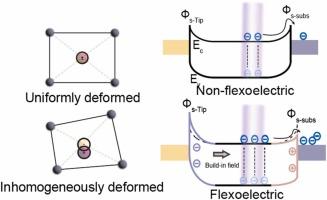Flexoelectric enhanced photovoltaic by charge transport modulation in 2D α-MoO3
IF 17.1
1区 材料科学
Q1 CHEMISTRY, PHYSICAL
引用次数: 0
Abstract
Photovoltaic effects in two-dimensional (2D) materials leverage atomic-scale quantum phenomena, enabling ultrathin energy-converting architectures beyond the limits of conventional semiconductors. The strong in-plane bonding combined with the interlayer van der Waals interactions in 2D metal-oxide semiconductors facilitates enhanced strain gradients for generating flexoelectric polarization. The polarization-induced built-in electric field further modulates the metal-semiconductor Schottky barrier, thereby controlling the material's photoresponse performances. Leveraging this mechanism, we synthesized single-crystalline 2D MoO3 via chemical vapor deposition (CVD). Piezoresponse force microscopy (PFM) confirmed its robust flexoelectric properties, while conductive atomic force microscopy (C-AFM) induced large strain gradients to enhance photovoltaic response. This work establishes a pathway for flexoelectricity-driven photovoltaic control and performance augmentation in monolithic materials.

二维α-MoO3电荷输运调制柔性电增强光伏
二维(2D)材料中的光伏效应利用原子尺度的量子现象,使超薄的能量转换架构超越了传统半导体的限制。在二维金属氧化物半导体中,强的平面内键结合层间范德华相互作用有利于增强应变梯度,从而产生挠曲电极化。极化诱导的内置电场进一步调节金属-半导体肖特基势垒,从而控制材料的光响应性能。利用这一机制,我们通过化学气相沉积(CVD)合成了单晶二维MoO3。压电响应力显微镜(PFM)证实了其强大的挠曲电性能,而导电原子力显微镜(C-AFM)诱导大应变梯度来增强光伏响应。这项工作为柔性电力驱动的光伏控制和单片材料的性能增强建立了一条途径。
本文章由计算机程序翻译,如有差异,请以英文原文为准。
求助全文
约1分钟内获得全文
求助全文
来源期刊

Nano Energy
CHEMISTRY, PHYSICAL-NANOSCIENCE & NANOTECHNOLOGY
CiteScore
30.30
自引率
7.40%
发文量
1207
审稿时长
23 days
期刊介绍:
Nano Energy is a multidisciplinary, rapid-publication forum of original peer-reviewed contributions on the science and engineering of nanomaterials and nanodevices used in all forms of energy harvesting, conversion, storage, utilization and policy. Through its mixture of articles, reviews, communications, research news, and information on key developments, Nano Energy provides a comprehensive coverage of this exciting and dynamic field which joins nanoscience and nanotechnology with energy science. The journal is relevant to all those who are interested in nanomaterials solutions to the energy problem.
Nano Energy publishes original experimental and theoretical research on all aspects of energy-related research which utilizes nanomaterials and nanotechnology. Manuscripts of four types are considered: review articles which inform readers of the latest research and advances in energy science; rapid communications which feature exciting research breakthroughs in the field; full-length articles which report comprehensive research developments; and news and opinions which comment on topical issues or express views on the developments in related fields.
 求助内容:
求助内容: 应助结果提醒方式:
应助结果提醒方式:


